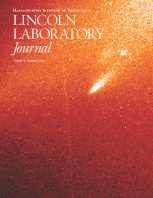Publications
Volume 14, Number 2
 |
|
Interference Mitigation Approaches for the Global Positioning System The satellite-based Global Positioning System (GPS) has evolved from its origins as a worldwide military navigation aid to a pervasive utility affecting all walks of life in the civil and military communities. As a result, the system must operate in a much wider range of environments than originally planned. Performance requirements have expanded, with a greater emphasis on substantially enhanced interference resistance and accuracy. This article focuses on these recent shifts and describes current efforts to address the updated requirements. First, we describe the GPS architecture and review its principles of operation. Then we outline the pressures in both the military and civil communities to upgrade performance. Next we cover some enhancements to GPS, and the program to implement them. We then examine efforts in the military community to address intentional interference, or jamming, with GPS operation. Mitigation of such jamming can be included in a user’s equipment or in the signals transmitted to this equipment. Finally, we describe a GPS augmentation approach, known as a GPS military pseudolite, which was designed to substantially reduce interference susceptibility. Research on the technical challenges associated with such a pseudolite system is currently being conducted at Lincoln Laboratory. Software Technologies for High-Performance Parallel Signal Processing Real-time signal processing consumes the majority of the world’s computing power. Increasingly, programmable parallel processors are used to address a wide variety of signal processing applications (e.g., scientific, video, wireless, medical, communication, encoding, radar, sonar, and imaging). In programmable systems the major challenge is no longer the speed of the hardware but the complexity of optimized software. Specifically, the key technical hurdle lies in mapping an algorithm onto a parallel computer in a general manner that preserves performance while providing software portability. We have developed the Parallel Vector Library (PVL) to allow signal processing algorithms to be written with high-level mathematical constructs that are independent of the underlying parallel mapping. Programs written using PVL can be ported to a wide range of parallel computers without sacrificing performance. Furthermore, the mapping concepts in PVL provide the infrastructure for enabling new capabilities such as fault tolerance and selfoptimization. This article discusses PVL with a particular emphasis on quantitative comparisons with standard parallel signal programming practices. Detection and Discovery of Near-Earth Asteroids by the LINEAR Program The Lincoln Near-Earth Asteroid Research (LINEAR) program, which applies space surveillance technology developed for the U.S. Air Force to discovering asteroids, has been operating for five years. During that time LINEAR has provided almost 65% of the worldwide discovery stream and has now discovered 50% of all known asteroids, including near-earth asteroids whose orbital parameters could allow them to pass close to the earth. In addition, LINEAR has become the leading ground-based discoverer of comets, with more than one hundred comets now named “LINEAR.” Generally, LINEAR discovers comets when they are far away from the sun on their inbound trajectory, thus allowing observation of the heating process commonly missed previously when comets were discovered closer to the sun. This article provides an update to recent enhancements of the LINEAR program, details the productivity of the program, and highlights some of the more interesting objects discovered. Recent Trends in Optical Lithography The fast-paced evolution of optical lithography has been a key enabler in the dramatic size reduction of semiconductor devices and circuits over the last three decades. Various methods have been devised to pattern at dimensions smaller than the wavelength used in the process. In addition, the patterning wavelength itself has been reduced and will continue to decrease in the future. As a result, it is expected that optical lithography will remain the technology of choice in lithography for at least another decade. Lincoln Laboratory has played a seminal role in the progress of optical lithography; it pioneered 193-nm lithography, which is used in advanced production, and 157-nm lithography, which is under active development. Lincoln Laboratory also initiated exploration of liquid-immersion lithography and studied the feasibility of 121-nm lithography. Many of the challenges related to practical implementation of short-wavelength optical lithography are materials-related, including engineering of new materials, improving on existing materials, and optimizing their photochemistry. This article examines the technical issues facing optical lithography and Lincoln Laboratory’s contributions toward their resolution. Subwavelength Optical Lithography with Phase-Shift Photomasks Optical lithography has been the patterning method of choice for the semiconductor industry for over three decades. Through a continual decrease in exposure wavelength and increase in lens numerical aperture, this technology has kept pace with the exponentially shrinking feature sizes predicted by Moore’s law. In the mid-1990s, minimum feature sizes on semiconductor chips began to drop below the available imaging wavelengths, ushering in the era of subwavelength optical lithography. Imaging in this challenging regime has been enabled by the development of resolution enhancement technologies (RETs) that work to overcome diffraction limits on imaging resolution. We have developed, as part of a Defense Advanced Research Projects Agency–sponsored program in advanced complementary metal-oxide semiconductor (CMOS) technology, phase-shift-photomask optical lithography processes capable of imaging features as small as 16% of the exposure wavelength. We have applied these processes to the development of advanced silicon-oninsulator (SOI) device technology utilizing standard commercial optical lithography equipment. We are also exploring methods of cost-effective implementation of this type of resolution enhancement technology for applications that require high-resolution imaging for relatively small quantities of wafers. |
|